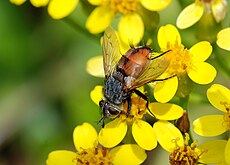

A calypter is either of two posterior lobes of the posterior margin of the forewing of flies between the extreme posterior wing base and the alula, which covers the halteres.[1]
The lower calypter is the proximal calypter (synonyms: squama (of some authors), tegula) and the upper calypter is the distal calypter (synonym: squamula).[2]
Species of the subsection Acalyptratae are noted for lacking calypters.[3]
References[edit]
- ^ McAlpine, J. F. (1981). Manual of Nearctic Diptera. Volume 1: Monograph: 27 / Agriculture Canada. Monograph. Ottawa: Canadian Government Publishing Centre. ISBN 978-0-660-10731-8.
- ^ Contributions to a manual of Palaearctic Diptera. 1: General and applied dipterology. Budapest: Science Herald. 2000. ISBN 978-963-04-8839-6.
- ^ "Volume Contents 127". Entomologia Experimentalis et Applicata. 127 (3). 2008-04-16. doi:10.1111/j.1570-7458.2008.volcontents_1.x. ISSN 0013-8703.
Well, that’s interesting to know that Psilotum nudum are known as whisk ferns. Psilotum nudum is the commoner species of the two. While the P. flaccidum is a rare species and is found in the tropical islands. Both the species are usually epiphytic in habit and grow upon tree ferns. These species may also be terrestrial and grow in humus or in the crevices of the rocks.
View the detailed Guide of Psilotum nudum: Detailed Study Of Psilotum Nudum (Whisk Fern), Classification, Anatomy, Reproduction